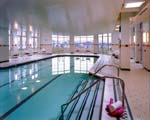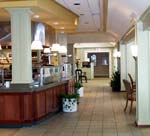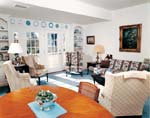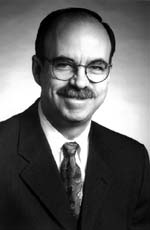
|
|
|
|
 |
|
Home Site Search Contact Us Subscribe
|
|
|
|
INSIGHT: When Boomers Retire...
Baby Boomers' retirement expectations are redefining an industry. by J. David Hoglund, FAIA, Perkins Eastman Architects July 8, 2003 Greasers, hippies, yuppies, trailing
boomers, aging boomers…you name it and the Baby Boomers have been called it!
This group constitutes the largest consumer demographic in our country. They
are influencing their parents’ retirement choices, and they will define their
own 20 years from now. Sixty-seven million strong,
the Boomers were born at the beginning of a cycle of unprecedented American
prosperity, power, and success. Valuing individualism, the most fortunate among
them have experienced constant and consistent upward mobility; nothing is
unobtainable. What are the Boomers’ retirement expectations? What do their
preferred communities look like? How will they redefine service, quality, and
environment? Why does it matter? The Senior Living Industry Historically, the principle
of design for residential facilities for the aging began with concepts borrowed
from hospital models and the housing market. There was very little
understanding of the users, few architects interested in the design of senior
living facilities, and a belief that the facilities did not require marketing
to secure residents. In recent years, this
industry has been rebelling against a series of products based on consumer
choice of 20 years ago to new models that require new thinking, new programs,
and new design. Today’s consumer does not accept the “one-size-fits-all”
approach. They want a residence that accommodates their widely varied
circumstances and needs, provides a continuum of services, and offers quality
across the board. Boomers’ Expectations Baby Boomers are in a wide
range of life stages, and have a variety of experiences and values. The
diversity of this generation presents many challenges to health care providers
– it is imperative to consider a broad spectrum of services and options. Boomers and their parents
have had different views of home ownership, influencing the decisions they make
when choosing retirement housing. The Boomers, born in the post-World War II
era, grew up in a booming economy. Rising incomes and plentiful jobs in the 1950s
and 1960s set off an explosion of suburban construction and home ownership.
Affluent Boomers are more knowledgeable and will demand more, looking to
maintain their lifestyle, rather than conform to available products and
services. Boomers’ parents, on the
other hand, matured during the Depression or World War II when services and
products were scarce or non-existent. Trained to save, this generation has
typically moderated their expenses and approached their housing and needs more
carefully and conservatively. As a result, over 75 percent of financial assets
in the United States are held by people over the age of 55. Boomers’ parents,
now well into their 70s and 80s, are making life-style and need-driven choices
and may be more accepting of the status quo; their expectations for privacy and
quality are again different than their own parents, who were raised during the
Depression. The Boomer Influence The oldest Boomers, some of
whom have already retired, will be making retirement community/service decisions
in the next five to 20 years and are clearly changing the industry.
Traditionally, Boomers have had a great influence on their parents’ decisions
regarding housing and services. We have found this generation looking at the
options and saying, “This is not what I want for Mom and Dad, and it’s
definitely not what I want for myself.” THE ARCHITECTURAL VISION:
- Possesses a philosophy
and commitment to aging in place. Boomers want and will demand
a lifestyle that supports their independence, with units that allow them to age
in place, services that respect their dignity, and activities that allow for
choice, self-governance, and physical well-being. The program and building
design must be flexible, so that a change in physical or mental health does not
necessitate a change in living environment. - Enhances customization and builds excitement into the dining experience. Residents want a range of
dining experiences and flexibility. Retirement community dining programs have
evolved to include diverse service options by introducing upscale restaurants,
grill rooms, clubhouses, takeout, and display cooking. - Views wellness as a lifestyle expectation. The Boomer generation is
competitive. Think about sports popular with Boomers, such as basketball, volleyball,
and racquetball, and facilities that accommodate tournaments. Some Del Webb
communities include lap pools with as many as six lanes for competitive events,
indoor running tracks, and rock climbing walls. The Manor at Yorktown offers
services by professionals certified in massage therapy, reiki, tai chi, yoga,
and personal training. - Integrate and enhance the outside environment. Boomers will want a garden
that they can dig in, not sit and stare at. Incorporate raised planters that
permit wheelchair and walker access and eliminate back stress. Offer a range of
heights so everyone can integrate gardening into their daily activities.
Provide easy access to water and use containers that can be brought inside
during cooler weather. At the Collington, residents grow their own vegetables
in an irrigated hilltop garden. - Create an environment that is a continuation of Boomers’ lifestyles. How Boomers have lived, in
terms of housing, amenities in their homes, space usage, etc. plays a
significant role in determining whether living units will be seen as a
continuation of their lifestyles or as an abrupt change. Create space for
washers and dryers, walk-in closets, kitchens with up-to-date appliances,
larger bedrooms, and multiple phone lines for computers and faxes. Options
include combining units, “bump-outs,” and sunrooms. Boomers are used to
purchasing services that make their lives more convenient. The Manor at
Yorktown is one of the first communities to integrate technology applications
into a solution that secures and enhances the environment. There is no need for
residents to carry cash. They can shop at a general store using a scanner that
adds purchases to their monthly statements. In the resident’s unit, an optional
touch screen monitor makes it easy to order room services, such as meals or
additional housekeeping, and also shop securely on the Internet, send e-mail,
or communicate with other residents. Twenty-four-hour security through
authenticated voice and face identification allows access to the building
without the need to carry keys. - Offer education/lifelong-learning opportunities. Link with a college or
university to gain exposure to new subjects and learning experiences to broaden
residents’ horizons. This is also an opportunity to use college campus
recreational facilities. Incorporate a Kinko’s-style service center, research
facilities, and resident offices to allow residents to pursue educational and
professional interests. - Provide privacy/personalization of space in nursing setting. Reduce/convert semi-private
rooms into private living spaces. Boomers will demand private rooms with
showers, etc. and a great deal of opportunity for personalization of space.
Older models of sharing rooms won’t work for a generation raised with a strong
sense of homeownership, turf, and privacy. - Assesses urban vs. rural locations. U.S.-based hospitality/hotel
companies such as Hyatt and Marriott, and other residential builders like
Brookdale, have been developing full-service, high-rise continuing care
retirement communities (CCRCs) in major
urban centers. Urban dwellers typically have a sophisticated interest in the
urban experience, which includes the cultural and educational opportunities
available to them. Facilities might also include lecture-style classrooms (with
interactive video connections), appropriately sized rooms for recitals and
other musical events, gallery-style spaces for art exhibits, and a library
appointed with research level amenities. - Redesign the
environment to support culture change and memory loss. Realize that what works well
for people with dementia is also good for people who do not have dementia.
Develop cluster designs that create small-scale environments within larger
complexes. This concept permits flexible settings for a variety of special care
needs ranging from short-term rehabilitation to dementia, and sub-acute and
hospice care. About the author: J. David
Hoglund, FAIA, is a partner
of Perkins Eastman and the managing principal of the Pittsburgh office. Hoglund
has focused his architectural career on improving the quality of life of older
adults through a new paradigm that combines housing and services in a uniquely
residential setting by reforming building standards, and has changed accepted
practice through research, writings, and presentations. Founded
in 1981, Perkins Eastman is
headquartered in New York and, with a staff of more than 400, maintains offices
in Pittsburgh, Stamford, CT, Charlotte, Chicago, San Francisco, and Toronto. |
(click on pictures to enlarge)  (Chuck Choi) Sun City Takatsuki, Japan: The design emphasizes choice by creating a variety of public spaces, including this relaxing garden tea lounge with a warm palette of dark elm and mica panels. (Chuck Choi) Buckingham's Choice, Maryland: Seniors see wellness as a lifestyle expectation, with an emphasis on activities that strengthen the mind and body...water therapy, weight training, and competitive sports are on the rise. (Perkins Eastman) Collington Episcopal Life Care Community, Maryland: Dining becomes an event by with a "display cooking" kitchen in the middle of the dining room, offering residents individual orders and preparation. (Bob Ruschak) Manor at Yorktown, Pennsylvania: Each residence features a bright garden style living room and a fully equipped kitchen and laundry. It is one of the first communities to integrate technology such as touch screen monitors making it easy to order room services, access the Internet, and send e-mails. J. David Hoglund, FAIA, managing principal, Perkins Eastman/Pittsburgh J. David Hoglund, FAIA, managing principal, Perkins Eastman/Pittsburgh |
© 2003 ArchNewsNow.com